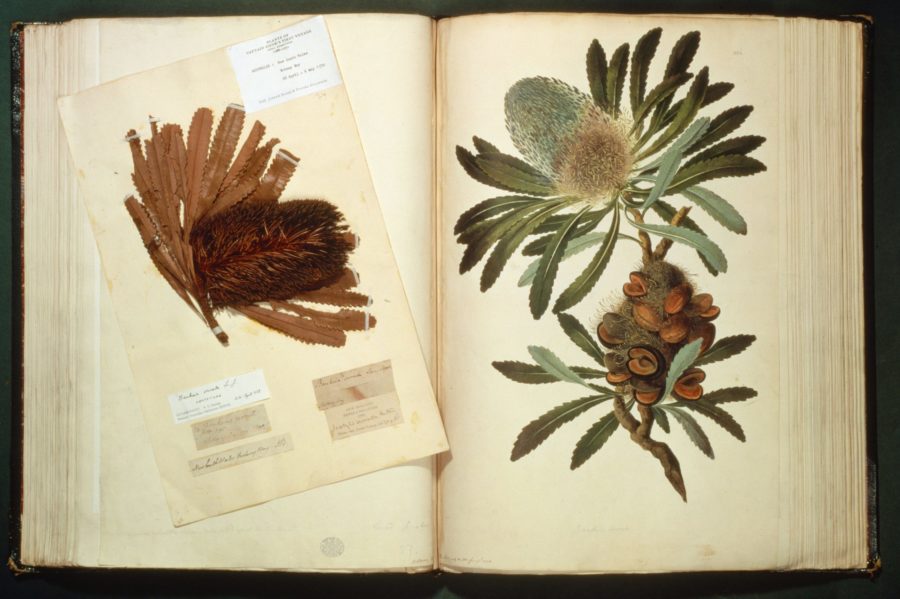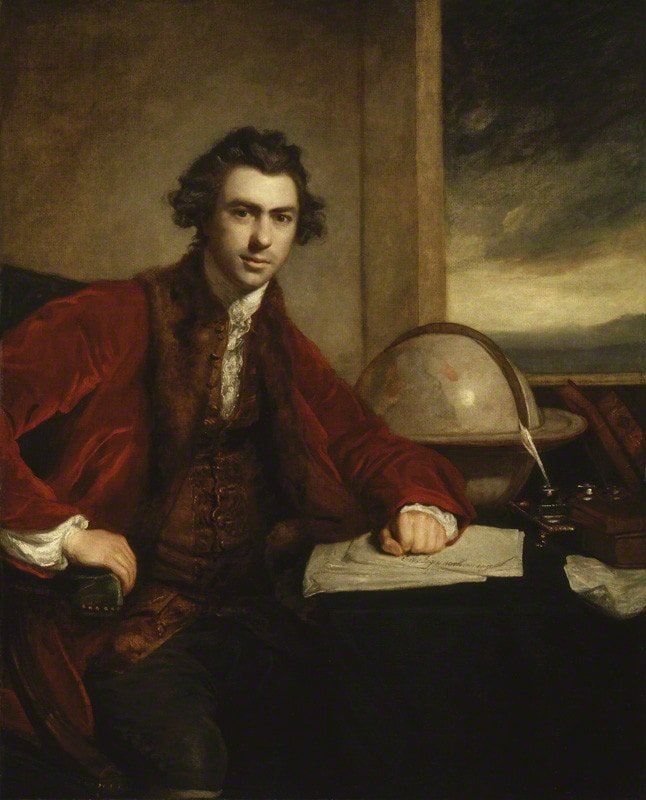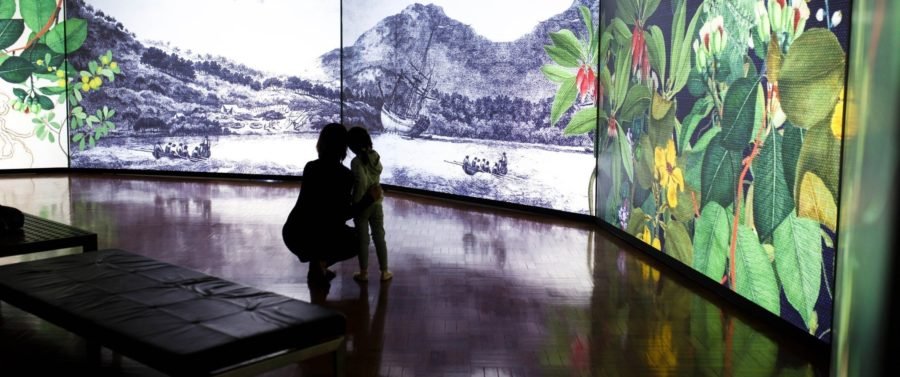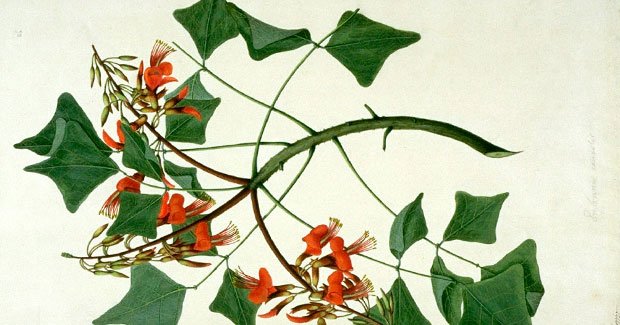When Joseph Banks first arrived in Australia

On 19 April 1770, Banks saw what is now Australia for the first time. In his diary, he noted: “The countrey this morn rose in gentle sloping hills which had the appearance of the highest fertility, every hill seemd to be cloth’d with trees of no mean size.”
From near today’s Batemans Bay, in NSW, the company could see cabbage tree palms (Livistona australis) with their telescopes and made what was perhaps the expedition’s first Australian botanical record. Unable to land, Cook sailed north, passing between what he called Cape Banks and Point Solander into Botany Bay (originally “Sting-Ray Harbour”, later “Botanist Harbour” then “Botanist Bay” in Cook’s journal and the crew stepped onto the land of the Dharawal people.
Parkinson noted: “The country is very level and fertile; the soil a kind of grey sand; and the climate mild: and though it was the beginning of winter when we arrived, everything seemed in perfection. There is a variety of flowering shrubs; a tree that yields gum; and a species of palm [Livistona australis], the berries of which are of two sorts; one small, eaten by the hogs, and the other, as large as a cherry, has a stone in it; it is of a pale crimson colour, and has the taste of sweet acid…for the number of curious plants we met with on shore, we called the bay Botany-bay.”
Banks, Solander and their assistants made specimens of 132 plant species in six days at Botany Bay, the first scientific collection of Australian flora. Parkinson made drawings of some 84. Considering the time of year, with little in flower, it was remarkably comprehensive – so much so that it is possible to reconstruct the scene as they would have found it. Their observations on the openness of the vegetation are part of the huge corpus of literature and illustrations that make a compelling case for the very heavy fire management and ecological modification of eastern Australia by Indigenous people.
After leaving Botany Bay, they spent seven or so days collecting specimens at other landings along the coast. In all, Parkinson made 94 sketches in the 14 days after they landed at Botany Bay. Banks was later to complain how little time Cook gave to natural-history collecting, which made each landfall a scramble for new plants.
The next collections were made at Bustard Bay, south-east of today’s Gladstone, in Queensland. Banks wrote: “Here we found a great variety of Plants, several however the same as those we ourselves had before seen in the Islands between the tropicks and others known to be natives of the east Indies, a sure mark that we were upon the point of leaving the Southern temperate Zone and for the future we must expect to meet with plants…part of which at least have been before seen by Europæans.”

The following day, they were at sea again (and eating the eponymous bustard), before touching at Thirsty Sound, between present-day Rockhampton and Mackay. Banks, on 29 May 1770, maintained a stiff upper lip about the hazards of plant-collecting, writing: “Found several Plants which we had not before seen…one kind of grass…was very troublesome to us: its sharp seeds were bearded backwards and whenever they stuck into our cloth[e]s were by these beards pushed forward till they got into the flesh: this grass was so plentifull that it was hardly possible to avoid it and with the Musketos that were likewise innumerable made walking almost intolerable. We were not however to be repulsd…”
On 11 June 1770, calamitously, Endeavour struck the Great Barrier Reef. She was freed from the coral on 17 June, and Banks, appearing undeterred, noted: “In the meantime Dr Solander and myself began our Plant gathering.” Endeavour was moved into the river now bearing her name, beached, and repaired. But the disaster allowed for seven weeks of exploration and collecting. On 21 June Banks recorded that he “began today to lay Plants in sand”, or dry them for preservation.
Parkinson drew 141 plant species, but by 28 July, Banks had had enough. “Botanizing with no kind of success,” he wrote. “The Plants were now intirely compleated and nothing new to be found, so that sailing is all we wish for if the wind would but allow us.”
Shortly afterwards the weather did become favourable, and Endeavour picked its way through the reef, heading north to complete Cook’s survey of 3220km of the Australian east coast, a coast he claimed for Britain and named New South Wales.
On 10 August, they sighted Lizard Island (Jiigurru), where, on 11 August 1770, Banks and Cook climbed the peak now known as Cooks Look to plan a way through the reef. Two days later they were at last “freed from all fears of shoals”. Looking back at the expedition’s rich collection, Banks wrote: “Of Plants in general the countrey afforded a far larger variety than its barren appearance seemd to promise. Many of these have no doubt properties which might be usefull, but for Physical and œconomical purposes which we were not able to investigate, could we have understood the Indians or made them by any means our friends we might perchance have learnt some of these; for tho their manner of life, but one degree removd from Brutes, does not seem to promise much yet they have a knowledge of plants as we plainly could percieve [sic] by their having names for them.”
His summation of Australia in general was noted, perhaps presciently, as follows: “Upon the whole New Holland, tho in every respect the most barren countrey I have seen, is not so bad but that between the productions of sea and Land a company of People who should have the misfortune of being shipwreckd upon it might support themselves, even by the resources that we have seen. Undoubtedly a longer stay and visiting different parts would discover many more.”
By October, the expedition reached Java, in modern Indonesia, where Parkinson drew 74 plants. While Endeavour was being repaired, the company began to succumb to disease. Two Tahitians Banks had brought along from Polynesia died in Batavia (Jakarta) and by Christmas Day, when the ship left Java, Banks, as well as Solander and several others, had contracted malaria.
Their voyage to the Cape of Good Hope, in South Africa, and on to St Helena, a remote volcanic outpost in the South Atlantic Ocean, saw the deaths of 22 of the company, including Spöring and Parkinson – probably from a combination of malaria and dysentery, while Banks may also have had typhoid. Of the 94 in the company that had set out with Cook, only 41 were to return alive to England, and, of Banks’ original nine, just four survived: Banks, Solander and their two field assistants.
This is an extract from ‘Sir Joseph Banks and his Florilegium’, first published in Issue 145 of Australian Geographic.



